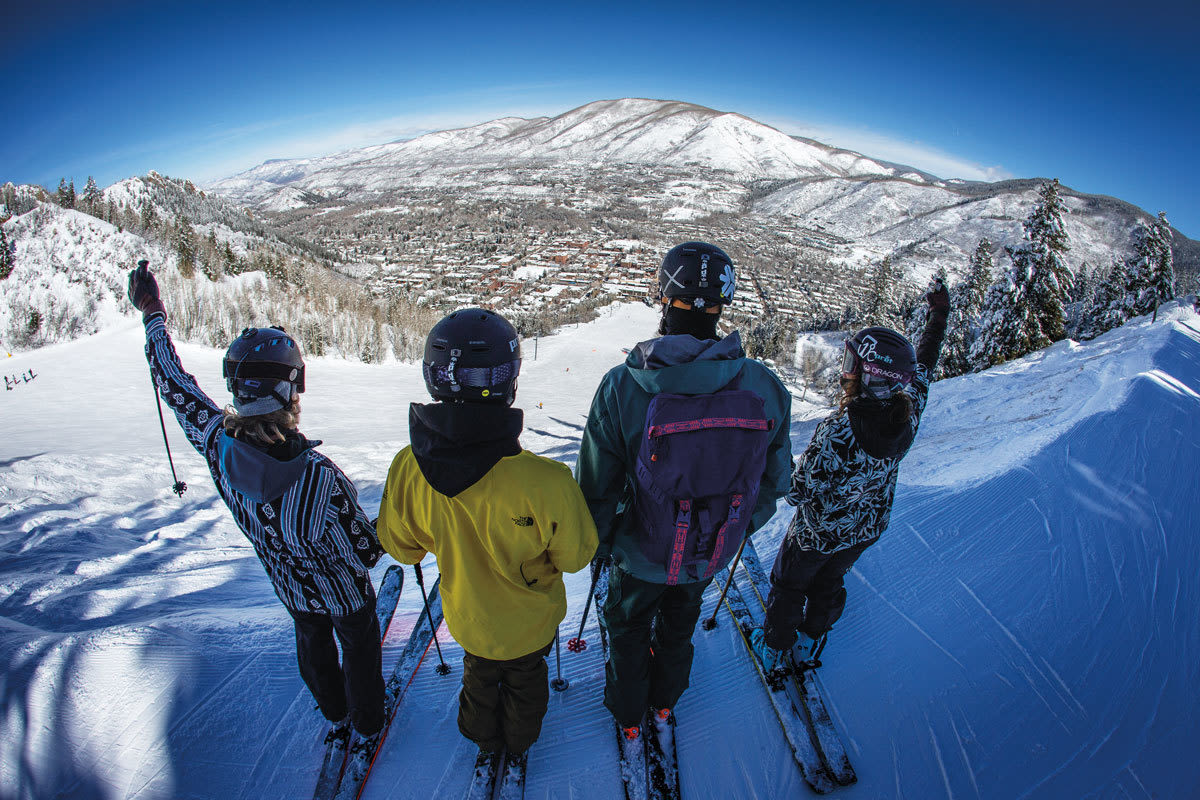
Where Should We Ski Today?
Image above: Drew Peterson, Zach Berman, Max Tabor, and Anna Tedesco on Aspen Mountain are ready to drop in.
You’ve just arrived in Aspen Snowmass for an eagerly anticipated ski vacation, and you face some choices: four ski mountains, 320 miles of trails, and countless potential combinations of conditions. Here, we provide answers to some of your most likely local scenarios.
I’m at Aspen Highlands for my kid’s ski race and want to get in some quick runs while she’s competing.
Take the Exhibition chairlift to midmountain, then lap the Cloud Nine lift. It serves mostly wide-open, groomed intermediate runs, but you can also dip into a classic mogul run (Scarlett’s) or challenge yourself with some short, ungroomed blacks (Alps, the Wall, Jug’s Hill). To ski alongside—and feel the terrain of—the race course, ride the Thunderbowl chair from the base, then hit up Golden Horn and Thunderbowl, some of the best intermediate runs at Aspen Snowmass.
We want to ski in the morning, then sit down for a great lunch.
Aspen Mountain’s base-to-summit gondola makes for an efficient morning of skiing before a satisfying in-town meal. Work up an appetite with a few T2Bs (top-to-bottom laps) interspersed with runs off the Ajax Express lift. Among the many dining options within a few blocks of the gondola: Ajax Tavern—right there at the base with a casual-gourmet French and American menu—and So Café on the top floor of the Aspen Art Museum. Enjoy a soup, salad, or sandwich from the ever-changing menu, along with views of Aspen Mountain and Independence Pass, then take in some culture for dessert.
Our ski group’s abilities range from beginner to expert; where can we all happily coexist?
Snowmass. Its 3,342 acres, spread across three peaks, offer something for everyone, and with planning it’s easy to meet up for lunch and breaks. Use the Elk Camp restaurant at the top of the gondola as your base camp. Learners can take lessons or practice close by at the Elk Camp Meadows beginner area, intermediates can enjoy the cruisers off the Elk Camp chair, and the more advanced in the group can venture up to Hanging Valley and the black runs off the High Alpine lift.
Where’s the best terrain for our young kids?
Buttermilk is more compact and easier to access than Snowmass (unless you’re staying at the latter), but both have great children’s centers and lessons for young beginner and low-intermediate skiers and riders (as well as advanced levels). Kids love the beginner/intermediate terrain park on Red Rover at West Buttermilk. On main Buttermilk, wide, impeccably groomed intermediate runs weave under the Summit Express chairlift, and lots of kids’ tree trails crisscross the ski area. Make sure to take a break at Fort Frog, a frontier-themed structure where little ones can explore, slide, throw snowballs, and—if in ski school—visit the candy counter.
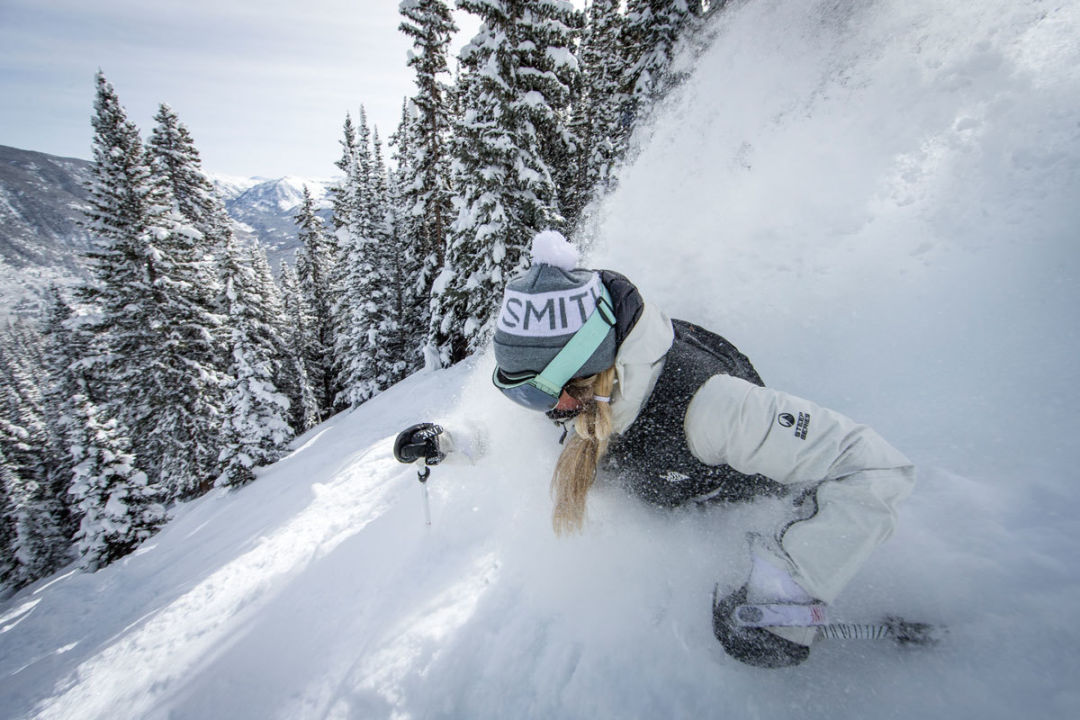
Hadley Hammer finds her powder stash.
Where can I find powder stashes after a storm?
With four mountains and plenty of places to look, we’re willing to give away a few secrets. At Aspen Highlands, while most people race to the Bowl or Deep Temerity, spend some more leisurely time exploring lower mountain runs like Bob’s Glade, Lower Stein, and the P-Chutes. At Snowmass, the far west and far east sides—specifically Sneaky’s Glades and Burnt Mountain Glades—offer widely spaced trees that cache snow. Aspen Mountain tracks up fast, so venture farther out to lower runs in the Dumps like Bonnie Bell or ski far left or far right in Bingo Glades. At Buttermilk, the Tiehack side holds powder for days, especially in the trees.
I want to rack up the likes for a scenic family photo or selfie.
- Buttermilk’s summit offers a backdrop of breathtaking, 14,018-foot Pyramid Peak.
- A dramatic valley behind the top of Snowmass’s Elk Camp chairlift sweeps toward the world-famous Maroon Bells, which are also 14ers.
- All three peaks are visible from Picnic Point at Aspen Highlands—easily accessed from the intermediate Robinson’s Run—along with, in the foreground, the snowfields of Maroon Bowl off the Highland Bowl ridge.
- On Aspen Mountain, Buckhorn Cabin, off the run of the same name, fronts a picture-perfect panorama of Mount Hayden, Highland Bowl, and a swath of the Elk Mountain Range; climb the ridge behind the cabin for even more of the same.
What’s the best way to ski two mountains in one day?
It’s a ritual among many locals to ski Aspen Mountain in the morning, then head to Highlands for a Bowl lap to top off the day; travel via the 15-minute free bus ride from Rubey Park, one block from the gondola. Another good combo: Buttermilk and Highlands. A free, dedicated shuttle connects them, and a day is plenty of time to get a good taste of both.
I want to hone my race skills.
Aspen Mountain and Snowmass each have NASTAR (National Standard Race) race courses, which, if you’re not familiar, use a handicap system that pits recreational racers against a US Ski Team pacesetter’s time, with the chance to earn a bronze, silver, gold, or platinum medal. Snowmass’s NASTAR course is below the Village Express midstation on Blue Grouse; on Aspen Mountain, it’s a short way from the summit on Silver Dip.
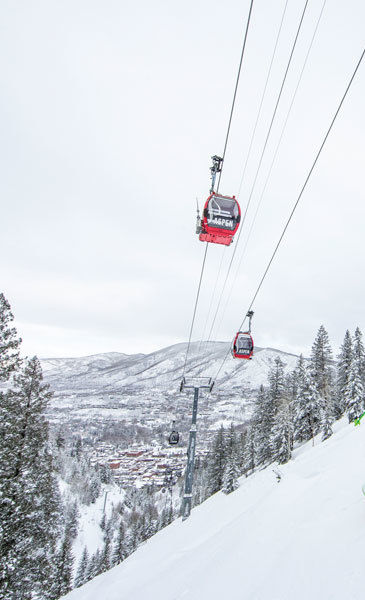
The Silver Queen Gondola
Which lift efficiently gives you the most vertical?
Aspen Mountain’s Silver Queen Gondola travels the 3,267 vertical feet from base to summit in 14 minutes. If you cruise fast, without stopping in Spar Gulch or Copper Bowl, it’s theoretically possible to ski some 20 laps in one day during extended spring operating hours (9 a.m. to 4 p.m.)—a mind-blowing 65,000-plus feet of vertical.
How do I get a local to show me around the mountains?
Aspen Snowmass ambassadors lead free, twice-daily orientation tours ( 10:30 a.m. and 1:30 p.m.) at all four mountains, giving you the lay of the land on intermediate runs for one to two hours. Specialty tours are also free of charge:
- At Aspen Mountain on Fridays and Aspen Highlands on Mondays ( 11 a.m. and 1 p.m. at each mountain), take a tour with an ambassador trained by the Aspen Historical Society that highlights the history of each ski area and find out the answers to questions such as “What’s that building around Kleenex Corner on Aspen Mountain?”
- On Wednesdays at Highlands, ambassadors take expert skiers and snowboarders to Highland Bowl; starting at 10 a.m., sign up for one of the coveted 10 daily spots at the ambassador stand by the Merry-Go-Round, and be prepared to do a warm-up run so the tour leader can make sure everyone’s fit for the hike and extreme terrain.
- At Snowmass, naturalist guides from the Aspen Center for Environmental Studies lead free daily ski tours ( 11 a.m. and 1 p.m.) for intermediates and up that focus on the high-alpine environment—think animal tracks, winter habitat, and more.
Another option: The Snowmass Over the Hillers—an open group of skiers and snowboarders over 50 led by a dedicated ambassador—meet on Tuesdays, 10 a.m., upstairs at the Ullrhof restaurant to ride together most of the day.
It’s blowing snow and visibility is low, but I’m game to tough it out. Where should I ski?
Ride the gondolas at Aspen Mountain and Snowmass to take a break from the elements. Aspen has ample advanced gladed runs, where trees help with depth perception and visibility, in areas like the Face of Bell, the Back of Bell, and the Dumps, which spill off International. Or stick to narrower intermediate runs like Spar Gulch, where other skiers can provide visual contrast. At Snowmass, avoid the top of the mountain; instead, ski powder from the Campground chairlift, in the trees off the Alpine Springs lift, and on the long, mellow intermediate runs served by the Two Creeks chair.

Connor Marx in the expert Snowmass Park
My kid wants to go huge; me, not so much. Where can we find some fun jumps and rails to go on together?
Buttermilk and Snowmass both offer world-class terrain parks. At Buttermilk, home of the Winter X Games for nearly two decades, a top-to-bottom series of terrain parks off the Summit Express gives beginner to advanced jibbers dozens of features to play on, culminating at the monster, 22-foot superpipe. (These parks close to the public from late December to late January in preparation for the X Games.) Red’s Rover off the West Buttermilk lift includes a great, mellow park to practice on. Snowmass boasts 80 features in three parks, including two pipes and a superpipe, that vary in degrees of difficulty; all feed into each other and are accessed by the Coney Glade chairlift.
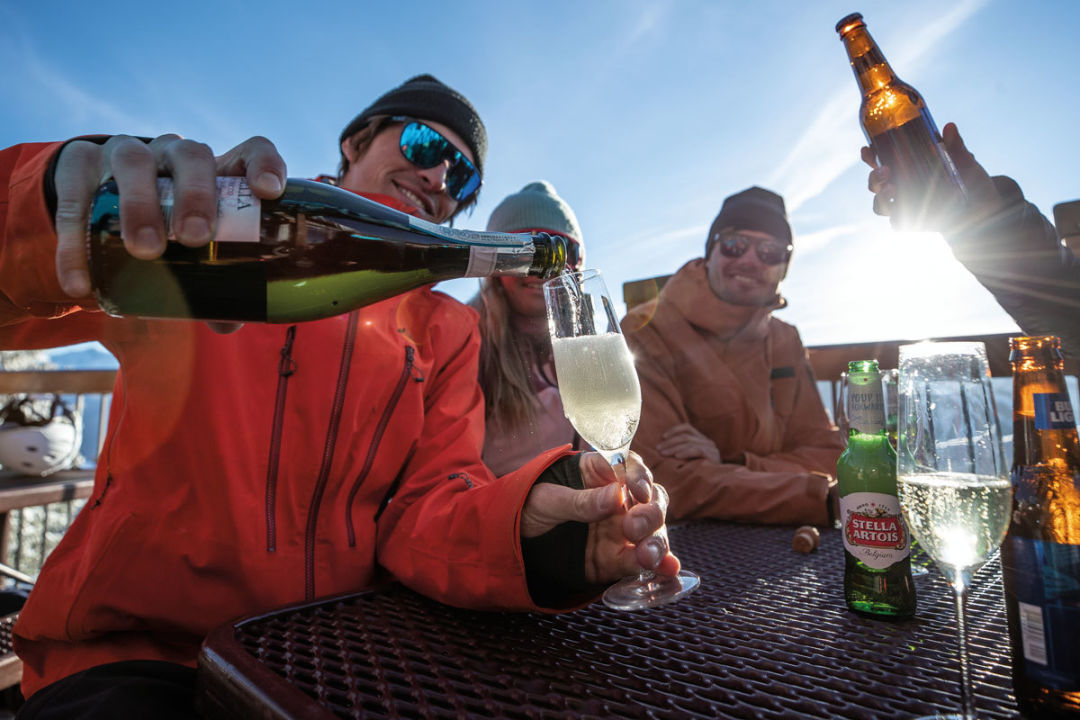
On-mountain après at the Sundeck
I want to start après-ski early on the mountain; what are my options?
You may have heard about a little place called … Cloud Nine? The midmountain restaurant at Aspen Highlands offers the wildest on-mountain party experience by far; in fact, the Champagne spraying, table dancing, and general club-like atmosphere has gotten so extreme that the 2 p.m. lunch seating is now 21 and over. Go with the flow and order up a bottle of Veuve.
At Snowmass, the Western-style Lynn Britt Cabin, with its generous deck and full bar, is ideal for a long late lunch or early après. Spring weekends feature a DJ, drink and food specials, and an outdoor lounge. Order a Velvet Falls Hot Chocolate spiced with peppermint schnapps and crumbled candy cane, and enjoy the ambience. When the weather’s not cooperating, head inside to the bar at Gwyn’s High Alpine, grab a seat by the wood-burning fireplace, and sip a hot toddy.
Long spring afternoons on Aspen Mountain foster lively scenes on the sun-splashed deck at Bonnie’s—accompany a slice of the world-famous strudel with a mug of hot spiced wine—and the Sundeck, which mixes a mean Bloody Mary.
We’re here for spring skiing, but the temps still plummet overnight; what time does the snow usually soften up?
As the weather warms up, timing is everything, especially on slopes that face east (i.e., sun in the morning) and west (afternoon sun). Consider waiting until 10 a.m. to hit the slopes. Then, follow the sun.
- On Aspen Mountain, hit the upper east side (Walsh’s, Hyrup’s, and Kristi), the Dumps, and the Back of Bell in the morning; save the Face of Bell for the afternoon.
- Ski Steeplechase at Highlands before lunch and Olympic Bowl after. In Highland Bowl, the lower Y zones favor the afternoon sun, while the B zones are usually better in the morning—the north-facing G zones usually hold the most consistent snow all day.
- Snowmass is probably the area least affected by spring sun, although the Big Burn generally skis better on spring mornings, while Elk Camp gets more sun in the afternoon.
- Pro tip: Lower-elevation runs don’t freeze as hard overnight, which makes the Shadow Mountain chairlift (Lift 1A) on Aspen Mountain, the lower half of Highlands, and most of Buttermilk good choices on a spring day.

Packy Westfeldt gets early-morning tracks on Aspen Mountain.
I want fresh tracks; I don’t want to fight crowds.
The First Tracks program, available on Aspen Mountain (daily) and Snowmass (Mondays, Wednesdays, Fridays), lets you and other upper-intermediate skiers schuss freshly groomed corduroy, sometimes with powder on top, before the lifts open to the general public. Sign up for this popular (and free!) perk one day before for Aspen Mountain and up to a month in advance for Snowmass; then plan on loading the gondola at 8 a.m. with a dedicated instructor to get the first turns on the mountain.
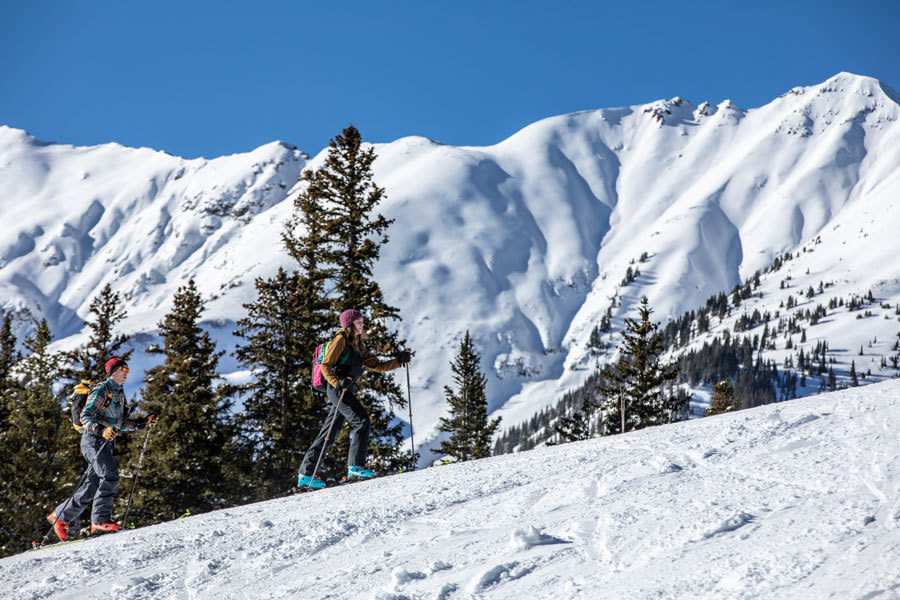
Skinning up at Snowmass
I've heard a lot about the uphilling craze; how can I try it?
Many local ski shops rent uphill gear; compared to your standard alpine ski gear, the equipment is lighter, and the boots are made to fit into bindings that release at the heel for uphill travel and clamp down for the descent. You’ll also need skins, which stick to the bottom of the skis and grip the snow to glide uphill. And it’s helpful to carry a backpack for water, snacks, and extra clothing layers. All four local ski areas allow uphilling, free of charge, but usually on a designated, marked route and with varying restrictions depending on the mountain. (Snowmass is the least restrictive.) Stay on the side of runs, and respect the common-courtesy policies found on the Aspen Snowmass website.
Want more? Hire a SkiCo private instructor to learn the finer points of uphilling on the ski area, or go with local guide services Aspen Alpine Guides or Aspen Expeditions to explore the backcountry under your own power.

My aim is bragging rights; what are the steepest runs here?
No one knows which is the steepest run, but it’s a point of friendly rivalry between the ski patrols. Snowmass, known for its great groomers, also boasts some impressive steeps. According to Guest Services Director Dave Gray, the mountain actually has about as much expert terrain—roughly 1,000 acres—as Highlands’ total acreage. Much of that gnarly vert can be found in the Cirque, where the entrance to Gowdy’s is a steep, narrow chute that’s a popular proving ground, and in Rock Island, where Hang-On Halvin’s offers the opportunity to get big air. On Highlands, the vertical winner in the Bowl is, perhaps surprisingly, not any of the runs from the top but the Hot Ys, which plummet lower down with a 48-degree steepest pitch and a 40-degree average pitch. If elevator-shaft steeps strung among tight trees is your thing, head into Eden, which dips into Loge Bowl on Highlands’ west side; the ski patrol considers it the area’s most challenging terrain. Aspen Mountain skiers like to prove their worth on the cliffy, rocky, rooty top part of S1 in the Dumps, or in the rarely open, rugged terrain off Traynor Ridge. But the hairiest run is not even on the trail map: Snake Pit, accessed via a gate on skier’s left of Kristi, is studded with steep, technical trees and optional cliffs.
How about some thigh-burning mogul runs to channel my inner Jonny Moseley?
Long Shot at Snowmass—at 5.3 miles, the longest run on all four mountains—is bumped up most days. On Highlands, almost every run in Deep Temerity serves up plenty of big, bad bumps—bigger and badder as the runs narrow toward the bottom. Aspen Mountain’s longest mogul runs are on Bell Mountain, particularly along the Ridge of Bell. Need some practice first? Lap Midnight or Roch Run for mellow, intermediate bumps.
I don’t do bumps. Where should I go?
Lucky for you, Aspen Snowmass offers immaculate grooming. On Aspen Mountain, ski westside trails like Ruthie’s Run, Spring Pitch, and Strawpile, all of which make up the FIS Alpine courses when World Cup races are held in Aspen. The wide-open runs of Snowmass’s Big Burn are a cruiser’s paradise, as are plenty of options off the Alpine Springs and Elk Camp chairlifts. Off the High Alpine lift, one of the prettiest runs is Green Cabin, with its panoramic views of the Cirque. Unbeknownst to many, Highlands offers ample groomers: access mellow, uncrowded runs like Red Onion, Riverside Dr, and Nugget from the Exhibition chair and high-speed cruisers like Gunbarrel and Kandahar from the Cloud Nine chair. Plus, the mountain offers one of the most exhilaratingly fun intermediate trails in the US: Golden Horn/Thunderbowl. Buttermilk has a slew of great groomers all over the mountain, including runs at Tiehack that are half groomed, half not, giving the option to dip into a few moguls if the mood strikes.
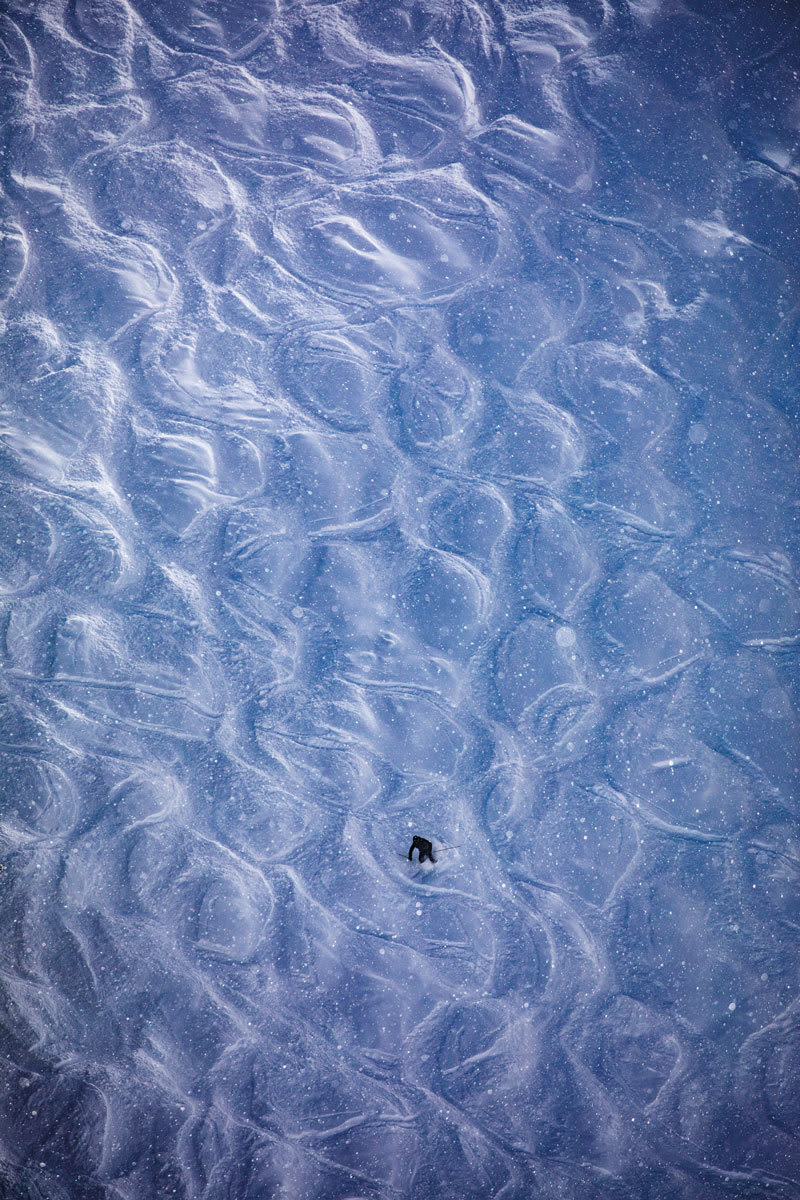
Moguls (winter only!) on Aspen Mountain
To Ski, First You Have to Get to the Mountain
The best way to get around: via the free bus. Frequent skier shuttles link all four ski areas; new this year, a direct bus runs to Highlands, Friday through Sunday, from the free Brush Creek parking lot midway between Aspen and Snowmass. Download the Transit app for all public transportation options, including Lyft.
If you must drive, your choices range from pricey slopeside valet service in Aspen to the free park-and-ride lot at Snowmass Town Park. Some lots also offer free parking for four or more in a vehicle—it pays to scroll through the Parking and Getting Around page on the Aspen Snowmass website to most efficiently plan progressing from Point A to Point B. Also new this year: check whether a skier parking lot is full on the Aspen Snowmass app.
Thanks
to the following local experts for their insights: Aspen Highlands Guest Services Manager Ben McCarter, Aspen Mountain ambassador and lifetime local Tony Vagneur, Aspen Skiing Company Senior Public Relations Manager Tucker Vest Burton and Public Relations Manager Liz Rovira, Snowmass Guest Services Manager Dave Gray, Aspen Historical Society History Coach (and former Aspen Highlands ambassador) Mike Monroney, and Rocky Mountain Institute Senior Director of Marketing and Communications (and former Aspen Mountain ambassador) Rebecca Cole














































